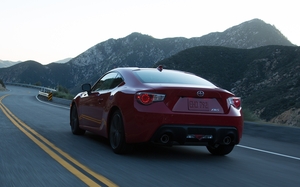 Scion was launched in 2003 ostensibly
as a laboratory to explore new dealership models and vehicle customizing where sharp angled cars were tabula rasa for car customizers. Toyota announced on Wednesday that the business is folding its
tents and rolling over to the Toyota, with cars like the new iM, and FRA becoming Toyotas.
Scion was launched in 2003 ostensibly
as a laboratory to explore new dealership models and vehicle customizing where sharp angled cars were tabula rasa for car customizers. Toyota announced on Wednesday that the business is folding its
tents and rolling over to the Toyota, with cars like the new iM, and FRA becoming Toyotas.
Commenting on the brief life of the brand, auto consultant Jim Sanfilippo suggested that Scion was
not driven by U.S. marketers, but that it came in from overseas as an idea driven by the lack of passion younger Americans had for Toyota, which no longer had a performance car and had discontinued
the Celica.
And it was a way to experiment with no-haggle pricing. “It was an experiment to run in the showroom, with minimal product investment. What’s not to like?” And, at
that time, they got the attention of the industry because Toyota was the most formidable brand, given that the Big Three at the time were adrift in a big way.
advertisement
advertisement
They had tapped Manchester,
England-based design shop Attik to create a dark, anarchic campaign for the cars with a “Hot Import Nights” aesthetic. Says Sanfilippo: “The initial marketing was brilliant, but
these were low-margin vehicles.” And, while the brand launched with radically designed vehicles, particularly the breadbox-on-wheels xB, it boxed itself into a corner, design-wise, and its cars
soon lost their edge, literally. “I don’t know if you can sustain cool, but you have to be on product. You have to be on the edge all the time.”
And then the demographic
results started coming in, and it was clear that the cars were not being purchased by younger people. The average age of the Scion owner had reached the high 40’s by 2013.
And as Sanfilippo points out, this was before Big Data, so
insights were not coming from listening to social media, which may have had a lot to do with the drifting aesthetic of the brand. “It is hard to sustain the need for authenticity, and in a way,
it is very reminiscent of Saturn: they let it die skipped product cycle and let it die.”
And then came the threat of new vehicles perhaps inspired by the xB, such as Kia’s
Soul -- an instant hit, partly because of the Hamster campaign that drove it, via Los Angeles-based David & Goliath. Suddenly Scion wasn’t so new any more. “Here we are in 2015, and
cars no longer relevant, and there is an existential threat is from small SUV’s from brands like Mazda and Honda. It’s a very solid decision on Toyota’s part because they are now
revisiting performance. And there’s nothing wrong with that [FR-S roadster, based on Subaru’s BRZ] being a Toyota.”
Edmunds analyst Jeremy Acevedo says there are
several issues impinging on Scion’s right to exist, not the least of which is that they are chasing a market niche that doesn’t exist today. “Younger people aren’t buying cars,
especially new cars. They are dragging their feet committing to the new car market, especially with ride sharing as a new option.” He notes that only about 12% of new-car buyers are Millennials,
and that 58% of new vehicles sold last month were trucks vans and SUV’s. “Nothing fits that bill in Scion’s stable.”